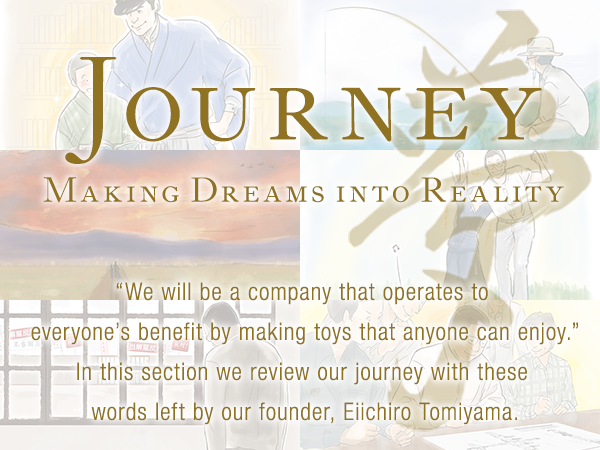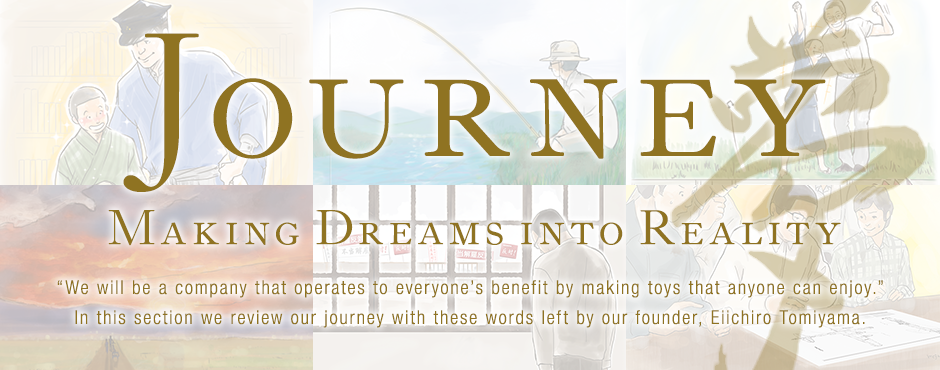Chapter 2Unyielding Conviction
1924-1949
The Founding of Tomiyama Toy Seisakusho
—Eiichiro Becomes Captain of His Own Ship—
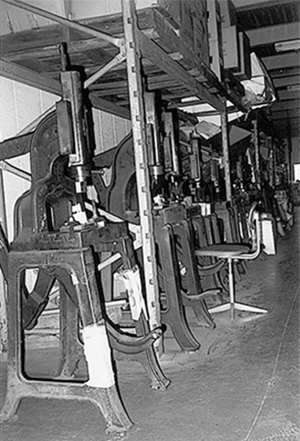
Eiichiro’s factory, Tomiyama Toy Seisakusho, started in a small workshop, with two foot presses and one press machine arranged on a dirt floor in a storefront area around 5.4 m wide. On the day he hung the brand new sign reading, somewhat modestly, “Tomiyama Toy Seisakusho” over the entranceway, Eiichiro had risen and swept the workshop clean and lit his cooking stove before dawn, then sat down quietly in front of a foot press. “Well—everything starts from now.”
It was February 2, 1924, the morning was freezing cold, and he could see his breath.
At the age of 11, Eiichiro had been so captivated by the sophistication and beautiful form of German toys in a foreign magazine, that he had sworn to himself that someday he would create toys that were just as good. Now, ten years later, he was taking the first real step towards realizing his dream.

After a long deliberation over the best choice for the inaugural toy to commemorate Tomiyama Toy Seisakusho’s founding, Eiichiro finally settled on a red clockwork racing car, the “Indian.” Confident of pouring all of his current skill into the new toy but uncertain over whether it would be accepted by the world, Eiichiro, even with his reputation for being pluckier than most, found it hard to describe the painful nervousness he felt when approaching the toy wholesalers. But all of his uncertainty evaporated when the owner of Asano Shoten, a toy wholesaler, gave him a word of commendation and encouragement, saying “It’s a splendid toy—both novel and well made. Well done, Mr. Tomiyama.”
Eiichiro, who had just started out on his own, found that his new creation was highly rated by the owner of Asano Shoten, who offered a higher price and ordered a greater quantity than Eiichiro had imagined. Partly to repay the kindness of the wholesaler as well, he renewed his promise to himself that he would become the best toy maker in Japan, making amazing toys that would be second to none.
In the end, as the owner of Asano Shoten had foreseen, the “Indian” became a hit in Japan and overseas, and after just two months the number of foot presses in the workshop had grown to five, and the busy hum of machinery continued from morning till night, without even taking break. In those days, Eiichiro’s workshop was lively and full of enthusiasm, with two workers, Yoshi and Hide joined by the apprentice Kisaburo Okuma from his hometown of Yoshikawa, and occasional help from local ladies from the neighborhood who packed boxes as a home industry.
Having successfully launched as the captain of his own ship, as the year drew to a close in December, Eiichiro received a proposal for an arranged marriage. His mother’s sister, Osen, brought him the proposal, unable to ignore the sight of her nephew seated continuously at the foot press from dawn till dusk. The negotiation proceeded unexpectedly quickly, and on January 21, 1925, just one year after he had started his business, Eiichiro found himself starting a happy household with Aki Koroku, the daughter of a wealthy farmer from Waseda Village (currently Misato City). It was the winter of his 22nd year.

Rather than the sweet days of newlywed life, the everyday life of a toy maker’s wife in Tokyo Shitamachi area awaited Aki, starting from the very next day after the wedding.
She rose before Eiichiro in the morning and when her work around the house was finished each day, she would join with the workers and local ladies to help with putting the finishing touches on the toys. Aki’s soft, white hands, unused to labor, except for needlework, soon changed into the rough hands of a toy maker’s wife, stained black with machine oil.
The young couple had no time to enjoy their newly-married life, either at home or in the factory. In the evenings they would walk together from Sugamo to Honjo to buy metal, pulling a cart behind them. It was a rare and precious time for them to be alone. Looking at Eiichiro’s profile with eyes gleaming like a child’s as he spoke about toys, Aki thought again about the joy of being married.
Exacting Standards for Manufacture—
“Tomiyama the Toy Airplane Maker”
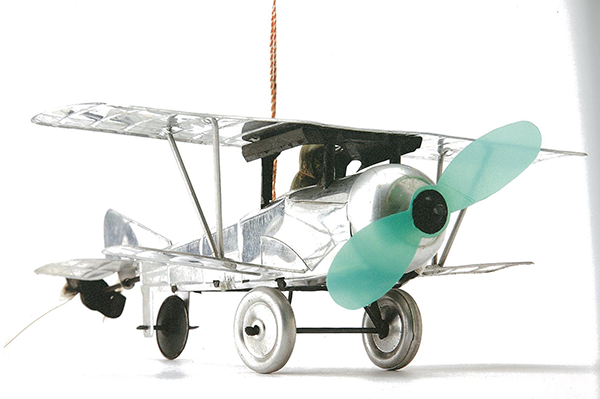
Eiichiro earned the nickname “Hikoki no Tomiyama (Tomiyama the Toy Airplane Maker)” within the industry for the suspended circling clockwork biplane, “Breguet.” Hung from the ceiling, the airplane would fly around in circles when the clockwork-powered propeller behind the wings turned. To make the body of the airplane light, it was made of aluminum, which was difficult to obtain in Japan at the time. Eiichiro would accept no compromise in the pursuit of making better products. His exacting requirements for manufacturing, knowledge, and passion, far exceeded those of others in the industry. Later, fellow toy maker Teizo Mizuno was to write of Eiichiro’s factory around this time:
At that time, the star of the airplane toys in Japan was surely Mr. Tomiyama’s “Breguet.” He once showed me his factory. I recall that it was built like a stage, with an elevated area at the front that served as a space for family and managers to supervise as well as a working space. Meanwhile, the many workmen undertook the hard sweating labor on the lower, more spacious area. Finished products were piled by the entranceway, and when I asked if they were goods that had been stowed, I was surprised when he said it was just one day’s worth of production, and indeed, one day’s worth of sales. Sometimes, when a single person rises to the top, it can stimulate other manufacturers’ desire to research and innovate, producing a stream of new sophisticated and novel models and giving impetus to a giant step forward. (Source: Tokyo Gangu Shouho)
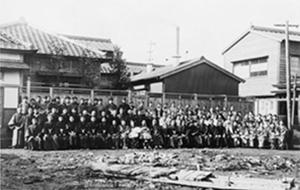
Unbeknown to him, Eiichiro’s passion for making toys had been quietly driving the development of the entire Japanese toy industry.
Unable to keep pace with the flood of orders, Eiichiro purchased a 1,056 m2 plot of land in Terajima Town, Mukojima Ward. He drew the blueprints for the new factory himself, and started work on construction.
In the spring of 1927, the toy industry’s first assembly line style factory was inaugurated. Another industry first was the establishment of a toy research department within the factory. The toy research department was the embodiment of Eiichiro’s strong belief that “Toys must have an element of fresh surprise, a sense of creativity, and design. Without these, there is no progress.”
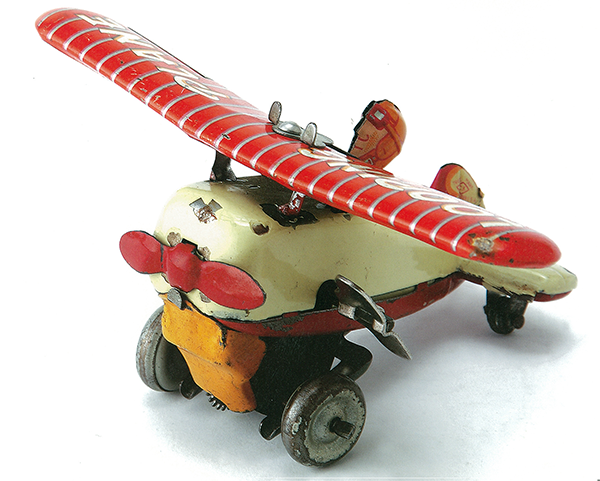
In October 1929, the ripples of the Great Depression that had started with the Wall Street Crash in the US reached Japan, and in January 1930, the cabinet of Osachi Hamaguchi lifted an embargo on the export of gold, throwing the Japanese economy into turmoil. The toy industry was affected too, and as exports fell and the domestic market shrank, many toy makers were unable to continue. Tomiyama Toy Seisakusho was no exception, and for the first time as the president, Eiichiro was forced to make painful decisions to ensure the survival of the business. Sadly, he was obliged to ask the local ladies who had run home businesses and several of the workmen to resign. Even in this dire situation, Eiichiro struggled to turn a tough spot into an opportunity. The remaining workers were divided into two groups to compete with each other on ways to cut expenses and improve efficiency while ensuring quality. Moreover, the research department was left alone, so that when the company had passed through this hard time, it would again be able to produce hit products that would excite the world. As a result of its development of new products under Eiichiro’s unshakable conviction, the research department produced two major hit products, the “Looping Plane” in 1930 and the “Welcome” in 1931.
Co-existence and Co-prosperity at Heart
—Aiming for Development of the Industry—
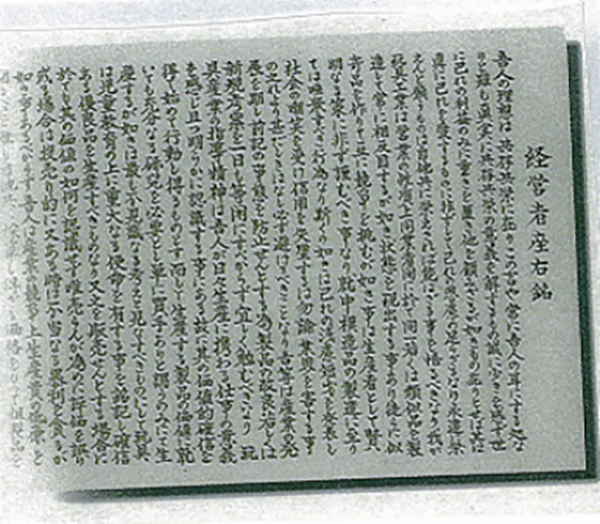
The wave of the Showa Depression swallowed up many of the toy makers in bankruptcy, as they were in an economically weak position within the industry structure led by manufacturing wholesalers.
“In order for the Japanese toy industry to compete globally, toy manufacturers must spur one another to improve, to continually modernize and rationalize, and to develop the latest production technologies and equipment,” said Eiichiro. “To that end, we must revise old trading traditions that remain between ourselves and manufacturing wholesalers such as discounting and product returns, and create a strong corporate structure.”
Seeing the hardship of his toy industry colleagues, Eiichiro was again reminded of the importance of banding together among weaker parties. The basis of this was the philosophy of Toyohiko Kagawa, a Christian and social reformer whom Eiichiro had been invited by his friends to hear speak at church one day around the time when he was founding the company. The underlying teaching of Mr. Kagawa’s philosophy was that “fraternity = mutual aid.” This teaching had quietly and steadily expanded in the depths of Eiichiro’s heart.
Eiichiro and other young men in the industry who had been influenced by Mr. Kagawa’s philosophy aimed to raise the standing of toy makers by joining forces, and in 1930 they established the Tokyo Toy Industry Association.
The business philosophy of Eiichiro and his companions, who strongly promoted co-existence and co-prosperity, was reflected in the association charter. The charter resonated with many small and medium-sized business owners who were involved in toy manufacturing, and the number of people seeking to join the association grew day by day.
Riding this wave of interest, Eiichiro and the other manufacturers advanced the activities of the association and established the Tokyo Toy Cooperative Sales Headquarters in Kuramae, Asakusa Ward. They implemented a resolute policy of setting the price of toys for themselves—something that had previously been done only by manufacturing wholesalers. It was a groundbreaking initiative within the Japanese toy industry, but the manufacturing wholesalers who had dominated the toy industry until that point were not inclined to take the change lying down. They imposed sanctions by boycotting the products of Tomiyama Toy Seisakusho and Kosuge Toy Seisakusho, both core members of the association. Eiichiro and his companions responded with a policy of selling directly to stalls and regional retailers in an all-out war of resistance. But this state of affairs could not continue for long. It was the rising demand among customers for toys made by Eiichiro and his companions that changed the situation.
In order to meet customer demand, the manufacturing wholesalers were obliged to stock Eiichiro’s and his companions’ toys in department stores and specialty shops, and this spurred a significant improvement in their trading relationship.
However, the story did not end entirely happily. Encouraged by their situation, Eiichiro and the others planned to dissolve the association and set up an industrial cooperative, but they met implacable resistance from the manufacturing wholesalers and their plans were temporarily derailed.
In 1933, the association members appealed to the public by drafting a founding document of more than 1,500 words describing their intended direction, entitled “Tokyo Toy Industry Association Industry Guidance Principles.” Guided by the spirit of co-existence and co-prosperity described in the document, they dedicated themselves to training and created a stream of outstanding toys. They also worked to improve their relationship with the manufacturing wholesalers, even establishing a social organization to promote good relations with them, called the “Fudokai” (later changed to the “Daishikai”).
Dark Shadow of War and Subsequent Recovery
—Toy Makers’ Pride as a Peace Industry—
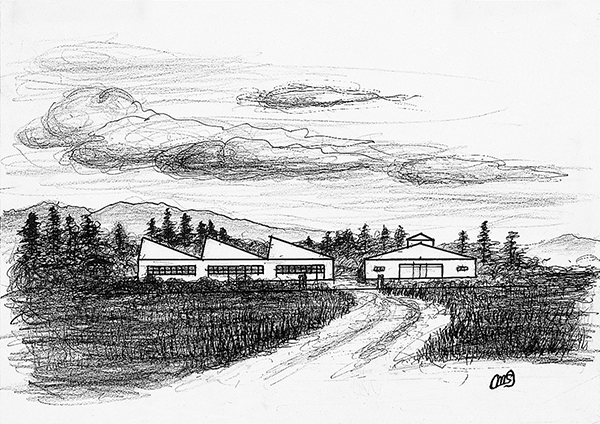
Export demand for toys increased year by year and Tomiyama Toy Seisakusho became unable to cope with orders at the Terajima Factory. In 1935, Eiichiro took steps to remedy the situation, securing a 33,000 m2 site in Okegawa City, Saitama Prefecture to construct a factory of 63 m by 12.6 m. The new factory started production two years later.
Eiichiro remained as particular as ever about manufacturing, even going to the lengths of building a factory for producing toys. Once it started production, the Okegawa Factory produced a string of hit products that were shipped all over the world, including a four-engined airplane, the “Clipper,” and the “Tank,” with metal caterpillar tracks produced by automatic machinery.
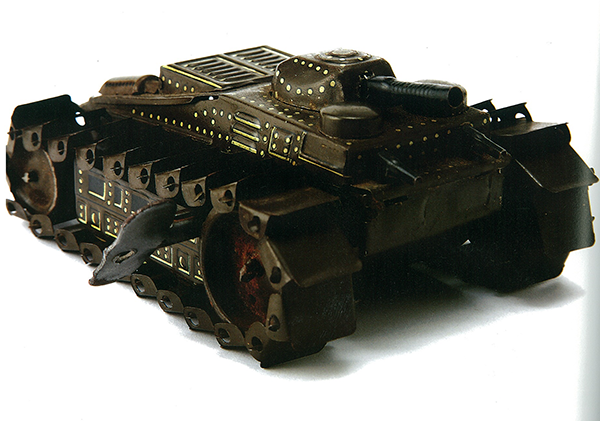
However, the affairs of the times were to cast a dark shadow over Eiichiro’s toy making.
Sparked by the Marco Polo Bridge Incident of July 7, 1937, the country plunged into the Sino-Japanese War.
In 1938, the Munitions Industries Mobilization Act was promulgated, placing some factories under state control. As the government-led factory control structure advanced, the toy industry was ordered to organize an industrial cooperative. Ironically, the industrial cooperative that Eiichiro and the other toy makers had longed for was realized with a single directive from the government.
On May 31, the Tokyo Metal Toys Industrial Cooperative was established. However, in reality it was nothing like the cooperative that Eiichiro and the others had wanted to create. The primary objective of the cooperative was to exert control over the supply of materials for making metal toys. As the Sino-Japanese War became protracted, such supply had itself become hopeless. The material for metal toys was diverted entirely to the manufacture of weapons and ammunition, and it became more difficult each day for Eiichiro and the other toy makers to secure materials.
To make matters worse, a raft of laws and regulations were enacted to secure weapons and ammunition, and finally on August 14, a directive was issued that banned the production of metal toys made with copper alloys or copper.
Unable to make toys any longer, Tomiyama Toy Seisakusho faced the prospect of having to terminate employment for 500 workers, and the younger workers, as if in response to the situation, were sent one by one to the war zones.
After less than one year in the sunshine, the machinery at the Okegawa Factory fell silent.
In 1939, the Second World War broke out.
Commercial treaties between Japan and the United States were abolished, making it impossible to export goods to the United States.
Even if one wanted to make toys, it was impossible to obtain materials. The only materials that could be obtained in place of metal were paper, plywood, wood, bamboo, and clay. Eiichiro threw himself into development of wooden toys. That year, he had a major hit with “Marching Soldier,” a toy whose upper body moved from side to side while moving forward when pulled along by a string. The toy received an outstanding handicraft award from the Ministry of Commerce and Industry.
In 1941, Eiichiro established the Taiyo Wood Factory for making wooden toys in Tateishi, Katsushika Ward, and continued to research production processes. He devised a method of softening wooden boards by boiling them so that they could be molded in a press, and realized the first ever mass-production of wooden products in Japan. Whatever the situation, Eiichiro never lost his spirit of inquisitiveness about toy making.
That year in December, Japan threw itself into the Pacific War.
The Tokyo Metal Toys Industrial Cooperative, which had also been a support for the toy makers despite its real nature, was eventually obliged to dissolve. It was a dark time for toy making.
Eiichiro was also obliged to shift to the munitions industry. The Taiyo Wood Factory was contracted by the Yokosuka Navy Base to make wooden blocks and pulleys for black out curtains used on battleships. Here too, Eiichiro used his creative ingenuity to make efficiency gains and establish a production process using the presses that were fundamental to toy making. Where craftsmen struggled to produce 3 or 4 pulleys a day, Eiichiro amazed everyone by achieving mass production of 300 pulleys a day. However, regardless of how much praise he received, Eiichiro felt a vast emptiness inside at being unable to make toys. With his toy making wings effectively clipped, he became keenly aware that a country at peace was the most important condition for the toy industry to flourish.
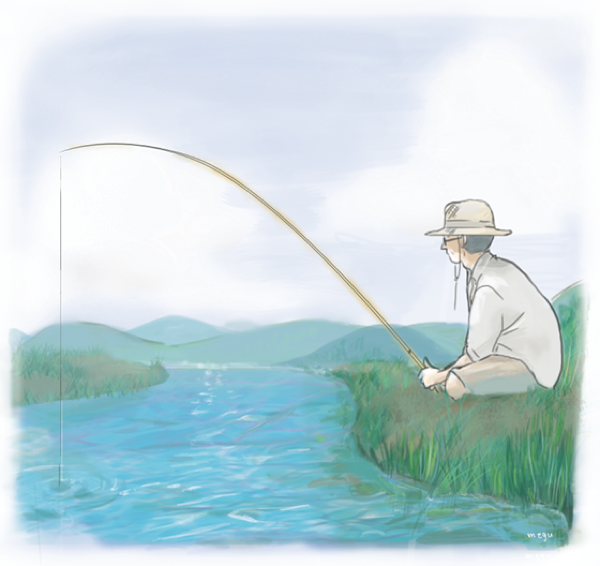
August 15, 1945, the end of the war.
Eiichiro dismantled the Terajima Factory and moved all the machinery to Tateishi. Now that he would finally be able to return to his beloved toy making, anyone could feel Eiichiro’s joy as if it were their own; and yet, for some reason Eiichiro did not start making toys.
He spent all day every day fishing by the local Nakagawa river. Watching him sitting by the river day in and day out, his friends couldn’t understand what his intentions were.
“The war is over. Why don’t you go back to making toys?” they asked.
Eiichiro replied simply, “Because my toys are crying.”
Although the war was over for Japan, its recovery was still a long way off, and there were many material shortages. It was extremely difficult in those days to obtain materials through official channels, and most people were obliged to take measures reluctantly just to survive. Even so, when a lumber dealer came to try and sell him tin, Eiichiro shouted, “Do you think I would make children’s toys out of black market tin?” and sent the man away.
Toy Industry Association who brought light through toys, with a toy known as the “Kosuge Jeep.” It was modeled on the jeeps of the occupying forces, and sold 100,000 units when it was launched in December 1945, becoming a major hit.
The following spring, in 1946, the “Sedan-Type Clockwork Car” by Mitsuji Sato of Nikko Toys hit the stores, selling 500,000 units before the year was out. In 1948, Eiichiro’s younger brother Kosaburo launched the “Feathered Chick,” which also became a 500,000-selling hit product.
Whether or not he knew about his colleagues’ activities, Eiichiro remained motionless. Tomiyama Toy Seisakusho, whose machinery had fallen silent, was gradually restarted by Kuniharu Kiso, who had returned from the war in 1946.
Unable to use black market materials, Eiichiro would shoulder his fishing pole early each morning and head out. His wife Aki waved him off without a word. Then with their eldest son, Chojiro (later to become the second president, Masanari Tomiyama), she would collect empty cans discarded by the occupying forces, clean them in caustic soda, then dismantle and flatten them for use as materials for making toys. The two worked earnestly at their task, waiting patiently for the day that they were sure would come, when Eiichiro would return to toy making.
Finally, in 1949 Eiichiro heard the news that the government controls were to be lifted, and he began to move once again. Tomiyama Toy Seisakusho reopened in Tateishi Honden Town, Katsushika Ward. Eiichiro was already moving forward with an endeavor that nobody would ever have even imagined. He was 46, and he was ready to start again. (Honorifics and title are omitted from the body text)


